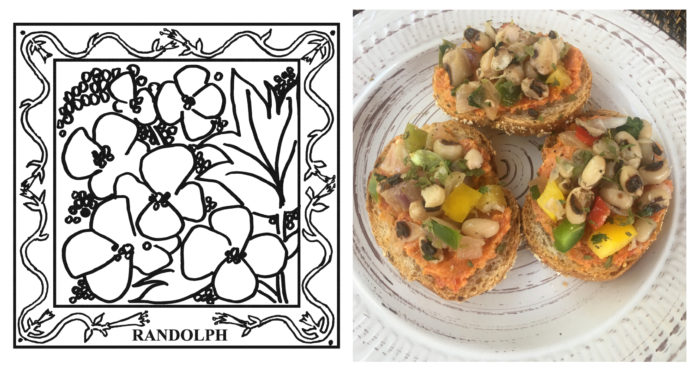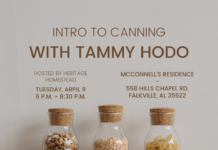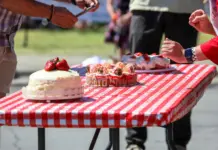
The Cullman Tribune is celebrating the Alabama Bicentennial (1819-2019) with statewide field reporting by Alabama Master Gardener/Botanical Artist Ben Johnson South. This year-long feature, “The 67-County Alabama Garden Party,” will spotlight different counties each week. Each county will get its own “quilt block,” along with a historical profile, and we’ll share a recipe specific to the area. At the end of the year, all 67 counties will be put in a book to commemorate the Bicentennial.
Randolph County
Beautifully green and still largely rural, Randolph County is on the Alabama-Georgia border. It was established in December 1832. Many white settlers were small-scale farmers moving west from the Carolinas and Georgia or south from Tennessee. These European-Americans were mainly English, Scots and Irish.
The men were skilled hunters, and abundant wildlife in Randolph County made for plentiful meat dishes. Women often gardened, planting the seeds they brought with them: beans, turnip seeds, pumpkin seeds and treasured flower seeds. The homesteaders had colorful zinnias which they called “Old Maids,” balsam known as “Touch-Me-Nots” and flowering lilacs.
This is a good place on our Bicentennial plant tour to talk about food preservation techniques of early-Alabama settlers. Drying fruits and vegetables was the most common way to preserve them to enjoy in the cold months. The metal, screw-top, canning jars invented by the New Jersey tinsmith, John Landis Mason, were not available until 1858. (Interesting culinary trivia: Mr. Mason also invented the first screw-top, saltshaker in 1858.)
One of the popular dried foods was called “leather-britches” and was simply green beans, threaded onto a string and hung to dry. Dried beans take about 24 hours to soak and soften. This meant whoever was cooking needed to plan ahead for meals. Pumpkins were peeled, cut into narrow strips and dried for mid-winter use. Skilled cooks would soften dried fruits for flavorful sauces.
Corn was the main, year-round food staple. Any year when corn crops didn’t flourish was going to be rough going. Popcorn for breakfast? Yes, it was popular during the early 1800s in Alabama. Ingenious cooks made their own cereal by folding popped corn into a bowl with sorghum and rich cream.
Apple seeds and peach pits were brought to Alabama by settlers. Once the trees fruited, the apples and peaches were peeled, cored and sliced into rings and then dried in the sun. Pears were usually dried with smaller seeds intact. Sun-dried fruits and vegetables have enjoyed a gastronomic revival, but you will need at least five straight days of 85F degree weather, preferably with direct sunlight and no insects. Dehydrators and oven-drying are other options.
Wild fruits such as strawberries, blackberries and muscadine grapes were dried and used as we use raisins. Preserved until needed, these prized, native fruits were soaked in water to use in tarts, cobblers, sonkers and pies.
“Persimmon leather” was another dried treat and could last almost indefinitely. The tangy dried fruits were later soaked in water and plumped for pies.
All kinds of plants were dried and preserved. Dried flowers and fragrant potpourris added beauty in Alabama settlers’ homes, especially in winter months. While researching traditional drying techniques, I found this easy, three-step process for drying hydrangea blossoms: 1) Cut blossoms in August-September with a 12”-18” stem. Remove all leaves. 2) Place flowers in a vase of fresh water covering half the height of the stems. 3) Keep the vase of flowers in a cool spot away from direct sun and enjoy the blossoms. Don’t add more water. THAT’S IT. It seems counterintuitive, but as the water evaporates the blossoms are preserved.
The natural plant beauty and farmed vegetation of Randolph County have been treasured since the early days of Alabama statehood. Ecology-aware residents today are preserving those pleasures for the next generations.
Here are other positive and pleasurable ways PLANTS + PEOPLE come together in Randolph County, Alabama and a recipe for Black-Eyed Pea Caviar with Sun-Dried Tomato Spread:
*RANDOLPH COUNTY FARMERS’ MARKET- 2959 County Road 333, Randolph County Equine and Ag Center, Wedowee, AL 36278; Wednesdays 8-11 a.m., May 15-Sept. 18
*WADLEY FARMERS’ MARKET- Main Street and Highland (Highway 77), Wadley, AL 36276; Tuesdays 8-11 a.m., May 14-Sept. 17; also, Sept. 21 is the date for the Wadley Bicentennial Celebration.
*RANDOLPH COUNTY FARMSTANDS- Bill Carson (Wadley), Blue House Farm (Wadley), David Johnson (Wedowee), Robert Bugg (Wadley), Tim and Lisa Brown (Newell), Will and Laura Moore (Woodland)
*LOCAL PLANT NURSERIES- Wedowee Landscape and Nursery; Morning Sun Nursery and Landscaping
*LOCAL SEED SOURCES- M.L. Awbrey Seed and Feed (Roanoke), Randolph County Farmers Cooperative (Wedowee, Tim Brown, manager), Burgess Farm Supply (Woodland)
*LAKE WEDOWEE- Fishing is the biggest draw at this 9,870-acre oasis on the Tallapoosa River, but the wooded area surrounding the lake is ideal for camping and hiking. The water quality of this lake is known as one of the finest in the Southeast. Just 90 minutes from metro-Atlanta, this playground is popular year-round and packed with tourists every summer.
*BLOSSOMING, REVITALIZED ROANOKE- This charming, historic city is a “must see” for everyone who needs an optimistic outlook on America these days. Call Randolph County cheerleader-in-charge, Dorothy Tidwell, at the Chamber of Commerce, and be prepared for a gushing lesson on all the ways the folks in this part of Alabama have come together to make it a great place to live, work and play. Ms. Tidwell told me about how gifted teacher, Merredith Sears, at Handley High School has made the area history come alive by leading archaeological digs especially of the Native Creek culture which goes back 6,000 years of agriculture and hunting before the Indian Removal Act. My favorite thing to learn about in Roanoke is how they transformed a burned-out movie theater into an amazing, grass-carpeted, open-air amphitheater; google “Main Street Theater Roanoke, Alabama” and be prepared to gush with oohs and aahs—take note other Alabama towns, this “green idea” and this lovely city are VERY INSPIRING!
*EAST ALABAMA CENTRAL MASTER GARDENERS ASSOCIATION- Master Gardener classes are offered each year through the Randolph County office of the Alabama Cooperative Extension System.
*BEST PLACE FOR A LANDSCAPE PHOTOGRAPHER or PAINTER- Tiffany Moore, coordinator of the Randolph County office of the Alabama Cooperative Extension System suggested two places: “Anywhere around beautiful Lake Wedowee,” and the old mill at Rock Mills.
*COLE CHRISTMAS TREE FARM- A choose-and-cut holiday adventure for the family; 2741 County Road 27, Woodland, AL 36280, 334-332-3574; Check their Facebook page for seasonal days/hours.
*AGRICULTURAL HERITAGE is celebrated each year at the East Alabama Tractor Exhibition, a family fun festival in Wedowee.
*PLANTING AN IDEA-The Randolph County office of the Alabama Cooperative Extension System trains consumers on a variety of food preservation techniques. With a few additional resources, freeze-drying processes could be added to the educational offerings. (One supplier online offers a large freeze-drying machine for $3,000). Freeze-dried foods, think NASA astronauts, retain original flavor, color and 97% of nutrients. Food that is freeze-dried and stored in an airtight container with an oxygen absorber will preserve for up to 25 years. Adding this 21st century food preservation equipment and training could be done with grant money or corporate underwriting. Awareness of this technique could be shared in all 67 Alabama counties via the ZOOM teleconferencing network, which is installed in each county office of the Alabama Cooperative Extension System.
Y’ALL COME to Randolph County on your 67-County Alabama Garden Party tour; we’ll preserve a place for you!
Many thanks to Tiffany Moore, coordinator of the Randolph County office of the Alabama Cooperative Extension System for the many local resources and highlights she shared. Also, thank you to Laurie Johnson for demonstrating the delicious way dried black-eyed peas and sun-dried tomatoes can be used to make a dee-lish Alabama garden party appetizer.
Randolph County Black-Eyed Pea Caviar with Sun-Dried Tomato Spread
The art of drying food, at its seasonal peak, has been a valued preservation method for centuries, even before electric ovens or dehydrators were around. My dad, who grew up on a north Texas farm in the 1920s, told me of climbing up on their barn to place peach slices on its tin roof to dry in the summer sun after they couldn’t eat any more pies and his mother ran out of canning supplies (or patience). Today, we can dry our foods electrically and have a plentiful supply of dried foods in our grocery stores. This recipe takes advantage of dried black-eyed peas (a Southern, “lucky” favorite) and sun-dried tomatoes – staples that can be pulled from the pantry at any time, combined with fresh flavors for a tasty and colorful topping for a crostini, or lettuce cups for those wanting a lighter bite.
Ingredients in rough order of use:
- 1/2 lb. dried black-eyed peas
- Finely diced red onion, 1/2 each green and yellow bell pepper, 1/2 fresh jalapeno (no seeds or pith)
- Olive oil, salt and black pepper
- Balsamic vinegar and your favorite hot sauce
- Juice from 1/2 a lemon
- 1 bunch of fresh parsley or cilantro (to your taste), chopped – reserve some for garnish
- 1/2 block of cream cheese (about 4 oz.)
- About 1/2 of an 8.5 ounce jar of sun-dried tomatoes, drained
- Local honey
- Toasted or grilled crostini bread rounds and/or butter or romaine lettuce cups for serving
Instructions:
- Soak dried peas – Follow the overnight soaking method on the package. Once soaked, drain, rinse and discard soak water.
- Cook peas – Using a large saucepan with a lid, cover peas with 2 inches of water, bring to a boil, reduce heat and simmer, covered until tender but not mushy – about an hour. Stir gently, occasionally, and check the liquid level, adding water if necessary. Season with black pepper and splashes of balsamic vinegar and hot sauce halfway through. Resist adding salt until the end of the cooking time since it makes the skins tough. Once tender, take off the heat, stir in about 3 tbsp. salt and let them stand in the hot, salted water for about 10 minutes – then drain well.
- Prep vegetables – In a sauté pan or skillet, sauté the diced bell peppers and jalapeno very lightly in oil – put the red onion in last since it loses its color quickly. Don’t cook long or completely – remove from the pan while they maintain their form and bright color (al dente). Set aside until peas are cooked, refrigerating if desired.
- Prep the tomato spread – Place the sundried tomatoes, cream cheese and a splash of local honey in a food processor and blend until mostly smooth. Refrigerate if not serving quickly.
- Make the pea “caviar” – In a large bowl, fold together the vegetables, peas and parsley (or cilantro) with 2 tbsp. olive oil and the lemon juice. Taste and season with salt, black pepper and hot sauce as desired. Can refrigerate for a couple of days, if desired.
- Enjoy! To serve, if refrigerated, let the tomato spread soften at room temperature and spread about a tbsp. onto a crostini or dollop into lettuce cups. Then spoon about a tbsp. of the pea mixture on top. Garnish with fresh parsley (or cilantro).
Also, check out Alabama Bicentennial: 200 ways to save Alabama for the next 200 years.
Copyright 2019 Humble Roots, LLC. All Rights Reserved.






























